
THE PLATE is an extremely satisfactory one, and represents the
male in breeding plumage. Its only fault is, that neither on
land nor in water do the birds ever stalk about with their legs
visible below them. As already mentioned, it is only when resting
on branches of trees that they are ever seen standing erect
on their legs. The chicks, with their funny little brush tails, are
correctly figured, but there is not generally the fulvous tinge on
the sides of the face and neck depicted in the plate. As a rule
these parts are white.
During the latter part of the autumn, the winter and the early
part of the spring, the males lose the collar round the neck,
which is' replaced by irregular banding similar to that on the
neck of the female ; the lower mandible becomes yellow, and
generally the entire plumage closely resembles that worn by the
female at all seasons ; but the male still retains the conspicuous
white patch on the primaries, which is entirely wanting in the
female, as also to a certain extent the metallic green on the
secondaries and coverts.
The young male of the year is almost precisely like the
female and wants the white patch on the primaries, and is only to
be distinguished from the female, I think, by dissection, though,
perhaps the lower mandible is never so yellow as in the
female.
Two OTHER closely-allied species, pulchMns and albipcnms,
of Gould (the latter differing from our bird only I believe m
its larger size) are known from Australia ; a third somewhat
different spccies,gcnerically separated by some authors, N.anrttus
is found in Madagascar and the adjacent regions of South
Africa.